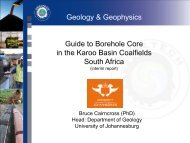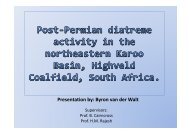coaltech upper olifants river catchment wetland inventory ...
coaltech upper olifants river catchment wetland inventory ...
coaltech upper olifants river catchment wetland inventory ...
You also want an ePaper? Increase the reach of your titles
YUMPU automatically turns print PDFs into web optimized ePapers that Google loves.
3.4.1.2 Floodplain riparian<br />
Floodplain riparian <strong>wetland</strong>s occur in lower-lying areas with or without a drainage channel.<br />
These <strong>wetland</strong>s have features such as oxbows, typically associated with floodplains and are<br />
inundated by overspill during a flooding event. This type of <strong>wetland</strong> consists of a permanently<br />
wet <strong>river</strong>ine zone, a seasonally or temporary inundated grassland zone and/or standing<br />
water in typical floodplain features such as oxbows, and back swamps. The oxbows and<br />
back swamps are only connected to the <strong>river</strong> system during a flooding event (Kotze et al<br />
2005, Palmer et al, Ward & Lambie 1999, Rogers 1995).<br />
3.4.2 Seepage<br />
Seepage <strong>wetland</strong>s occur where groundwater emerges, generally at faults or joints in the<br />
underlaying geology, or at the junction of a permeable layer on an impermeable layer. The<br />
soil is normally saturated and can contain peat. It is very difficult to quantify the nutrient<br />
removal function of the seepage <strong>wetland</strong>s. The groundwater flow should be measured, as<br />
well as the diversity of nutrients in the groundwater, as a starting point to quantify the nutrient<br />
removal. In addition, there is a lack of information on the evaporative losses from seeps. The<br />
seeps may also receive contaminated runoff during a rainfall event. The portions of nutrients<br />
originating from the different sources are difficult to determine (Palmer et al 2002, Deocampo<br />
1997).<br />
Springs and seeps can be seasonal, permanent, diffuse or point source. These <strong>wetland</strong>s can<br />
basically be divided into two groups based on the geohydrology, namely confined and<br />
unconfined. The groundwater of unconfined <strong>wetland</strong>s occurs mostly close to the surface and<br />
the hydrolic conduit is unconfined. In confined <strong>wetland</strong>s the groundwater is normally deep<br />
underground and is forced to the surface by some pressure, e.g. heat. The hydrolic conduits<br />
are confined by the presence of relatively impermeable layers. Most of the seeps are<br />
unconfined and seasonal, whereas springs are confined and seasonal or permanent. The<br />
aerial extent of seeps is regulated by the landform setting and the volume of discharged<br />
water (Palmer et al 2002, Deocampo 1997).<br />
Seeps contain both vertical and horizontal flow, while vertical flow is more significant for<br />
confined springs. In an unconfined seep the soil is saturated and horizontal surface flow is<br />
taking place (Palmer et al 2002).<br />
Wetland Database for UORC - 31 -




